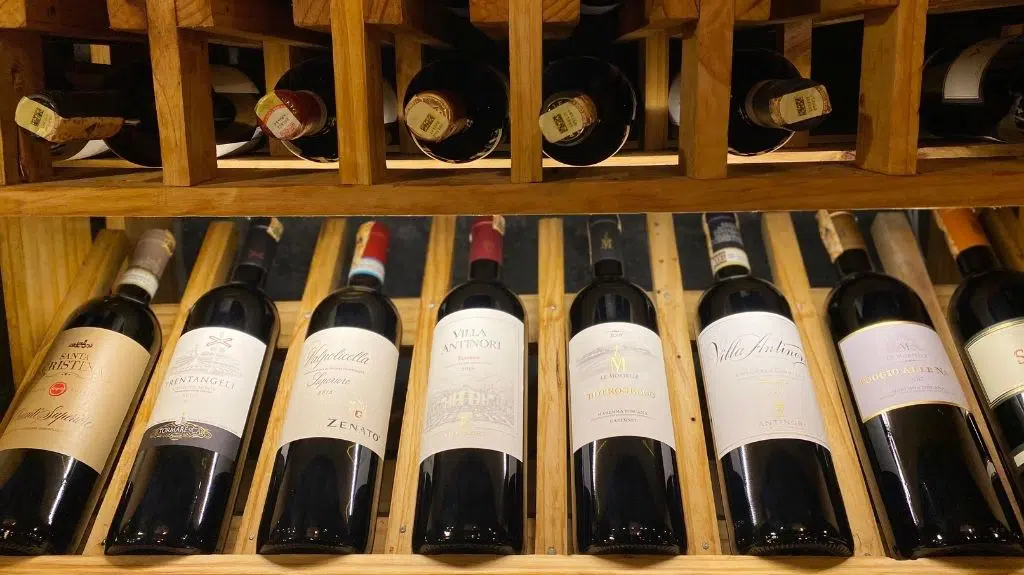How to store wine to keep it in top condition

It’s a question that comes up often: what’s the best way to keep wine? There are many different factors to consider. Is it best to store wine bottles standing up or lying down? What is the best temperature to store wine? How long can wine bottles be kept before opening?
Taking a sip of wine only to find it has been spoiled is disappointing; this applies whether you’re a wine connoisseur or just enjoy a glass of wine occasionally with a meal. Storing wine correctly will help it last longer. In this article we explain how, and how long, to store wine – so that your wine is in tip-top condition when you open the bottle.
How time affects wine
Although we may think of wine as being a fixed thing once it’s in the bottle, it’s important to understand that it does evolve over time. This is known as aging. It occurs slowly over time as natural chemical reactions take place within the wine, creating an arc of enjoyability. This happens at different rates depending on the type of wine and the production process.
Young wines can be quite harshly acidic and tannic; but over time subtleties and complexities in the flavours become more noticeable, and tannins become more rounded and soft. Many people consider this a trend towards a peak of flavour. But in reality, as the balance changes within the wine, different characteristics ebb and flow and appeal to different palates at different times. So whether an aging wine has reached its peak of perfection or not is a matter of personal taste. But past a certain point, those continuing chemical reactions begin to introduce less desirable attributes and the wine will no longer be as appealing.
How well a wine is suited to aging depends on the amounts of acidity, tannins and residual sugar present; these help preserve the wine’s flavours. In general, the more acidity, tannins or residual sugar, the longer you can keep the wine.
Keep your wine at a steady, cool temperature
The optimum temperature for storing wine depends on the type of wine, however a steady “cool” is best. Big variations in temperature and prolonged exposure to either heat or very low temperatures are the main things to avoid.
As a guide, you should not let your wine’s temperature rise over 24 degrees or fall far enough to freeze. If you aren’t lucky enough to own a wine cellar to keep your wine at a constant temperature (let’s face it, most of us aren’t), the best way to avoid damage to your wine during hot weather is to put it in the fridge. Even red wine will thank you for rescuing it from heat; just remember to give the wine time to come back to optimal serving temperature before opening the bottle.
Exposure to heat changes the flavours in wine, making it taste like stewed fruit, or sometimes dulling the flavour so that it seems “flat”. Now your wine has been “cooked”, and it’s a thoroughly disappointing sip. In truth, the only time you want to cook wine is when you are adding it to a dish like beef bourguignon, or if you are making a mulled wine for a winter treat.
Wine is generally more able to handle lower temperatures than heat; the natural aging process slows down at low temperatures. However it isn’t a good idea to store bottles in your fridge indefinitely; prolonged cold may affect the flavour of your wine too and also dry out the cork (more on that later).
Turn out the lights
Sunlight and fluorescent light (both containing UV rays) can damage the flavour of wine. UV light changes the types of chemical reactions taking place within to create undesirable compounds that smell and taste bad. This is known as “light strike”.
White wine is at greatest risk of light strike, because it is usually bottled in clear glass which does nothing to protect it from UV rays. Spoilage can occur in as little as 3 hours in direct sunlight. On the other hand, the dark green glass often used to bottle red wine greatly reduces the amount of UV passing through it.
So it’s best to store your wine somewhere dark. If you have a wine cellar, perfect. Otherwise a cupboard, a corner or hallway away from direct light. Even a fridge, particularly in hot weather (just remember to give the wine time to warm up before serving).
Of course you should also consider wine storage when you go into a shop to buy wine; choose a bottle that has not been kept in a window or stored directly under fluorescent bulbs.
Consider humidity
The amount of moisture in the environment can affect wine bottles sealed with a cork. Moist, humid air can encourage the growth of mould. This may not affect the wine itself, however it can be difficult to remove a crumbling cork from the bottle.
In contrast, very dry conditions can cause the cork to shrink, allowing oxygen into the bottle and damaging your wine by changing its flavour through oxidation. And a shrunken cork may allow the wine to leak out if the bottle is lying flat. However, this is unlikely to happen unless you live in a desert or store your wine in the fridge for too long.
Don’t shake the bottle
Movement can disturb sediment present in the bottle, so if you have moved wine, for example after purchasing it at a shop and taking it home, allow it to rest quietly before opening. Research has shown that vibration has negative effects on wine, reducing and dulling the flavours and aromatics whilst also introducing some undesirable flavours. Try not to jostle or shake wine, or subject it to vibrations when in storage.
Keep wine bottles upright or lying down?
The conventional wisdom is to lay bottles flat, to ensure the wine stays in contact with the cork and stop it from shrinking. However, some notable cork producers refute this idea, insisting that whether you stand your bottles up or lay them down makes no difference to the cork wetness; in fact temperature is the main risk factor to the wine.
And of course, many wines are now bottled with either a synthetic polymer cork or a screwcap closure; this means the issue of cork wetness and expansion doesn’t arise. So if you want to lay your bottles down, do; and if you prefer to store them upright, that’s okay too.
How long can wine be stored?
If your wine is in a sealed bottle, under optimal conditions you can potentially store it for quite a long time. In fact, depending on the type of wine, anything from about a year to several decades. The more mass-produced and processed wines are meant to be drunk as they are, within 12-18 months of production; conversely, winemakers can also build wines with the express intention of developing their flavours and characters over many years as the wines age and mature.
Often, there will be information on the label indicating how long to keep the bottle before opening; in the absence of pointers, however, a rule of thumb would be the more expensive the bottle, the more likely it is to store well for longer. You can also find plenty of information about particular wines on the Internet; sites such as CellarTracker and Vivino offer tasting notes and reviews of thousands of different wines.
The higher tannin content of red wines means they are better suited to keeping for long periods than whites. Fuller-bodied red wines will age better than lighter-bodied reds. Oak-treated wines often require aging for a short while, so perhaps keep these for 3-5 years before opening. And some white wines also age well, including sparkling wines such as champagne; don’t feel your personal cellar should be exclusively made up of reds.
But because the wine’s different characters develop over time, personal taste definitely comes into play; for example, while your friend may prefer a chardonnay that has become creamier with age, you might prefer the bright fruity acidity of its youth. In other words, how long you store your wine doesn’t just depend on whether you can provide good environmental conditions over a long period; your own preferences for youth versus age, mass-produced versus small batch crafted, etc. are equally important. You can only find this out through trial and error, time and effort; it sounds like an enjoyable project to me!
